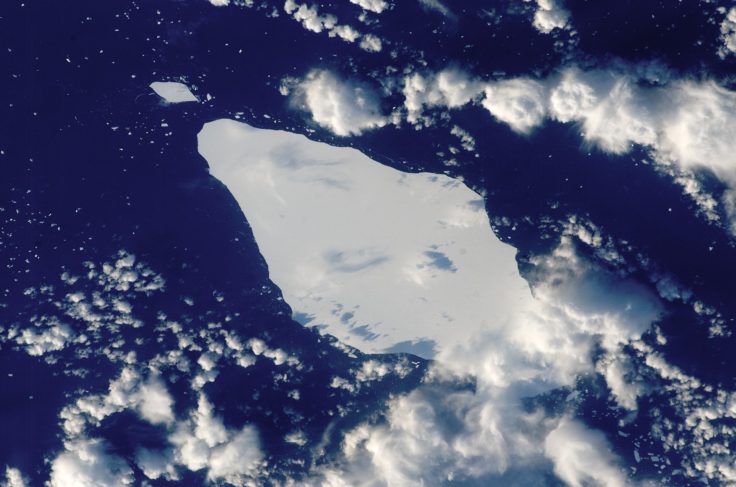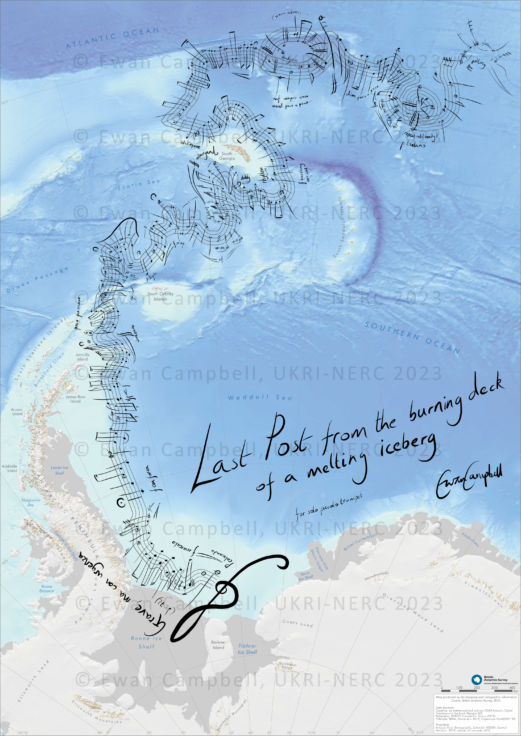Last Post from the burning decks of a melting iceberg
22 March, 2023
Composer Ewan Campbell has written a piece of music for trumpet inspired by the 21-year journey of the A22a iceberg. The new composition was also illustrated onto a British Antarctic Survey map charting the path of iceberg.
A22a was almost the size of Luxembourg, and calved from Antarctic 1986 and travelled over 9,000km before breaking up and melting in the Southern Atlantic Ocean.
Commissioned by British Antarctic Survey, the new composition follows the lifecycle of the iceberg from calving to break-up, as well as drawing attention to the threat of climate change.
Composer – Ewan Campbell
Trumpet – Simon Desbruslais
Cartography – Laura Gerrish
Cinematography – Tom Besley
Composer Ewan Campbell on Last Post from the decks of a melting iceberg
The boy stood on the burning deck
Whence all but he had fled;Casabianca, Felicia Hemans
Antarctica is sending us messages.
These messages are posted as gigantic floating ice envelopes bearing existentially important information about the state of the earth’s climate to those who care to understand.
The message is simple and blunt: the frozen continent is melting. However, what is almost impossible to mentally circumnavigate is the incredible scale of these messages.
Iceberg calving is a natural part of the life cycle of ice shelves, often in the form of ‘small’ icebergs, less than 1km square. However, some calving events are of such epic proportions that they completely transform the sea ice layout and can result in the redrawing of the Antarctic maps.
One epic calving event occurred in 1986. Three vast tabular ice-islands with a combined area twice the size of Kent and sheer cliffs that dropped 400m, almost four times the height of the Dover cliffs. Three ice-messages were posted that year, but each took a very different journey. The largest A23 remains in the Weddell Sea. The smallest A24 got caught by undersea currents and was swept out towards the Falklands. A22a (having split early) started out almost the size of Luxembourg and went on a 21-year journey, moving initially at a glacial pace through the packed sea ice of the Weddell Sea Gyre, past the mountainous Antarctic Peninsula, swept with gathering pace round South Georgia, and eventually broke up in the South Atlantic Ocean. By May 2007 it was still the size of ‘seven Manhattans’ and had travelled far enough north to be photographed by the crew of the International Space Station.

A22a was roughly rectangular and as flat and white as paper. This vast ice-envelope landed on my desk in early 2020. I was struck by the story of these huge floating islands on their daring sea voyages, and of the tragic climate warning they convey. I have attempted to translate this message into musical form, by writing music directly onto the path of A22a’s journey. It might appear unusual to notate music on maps, but I’m interested in the calligraphic beauty of classical music notation and how, by working with cartography, I can bring musical expression to interact with non-musical subjects directly, as well as metaphorically. I am grateful for the cartographic assistance of Laura Gerrish, from the BAS mapping department, who kindly created musical staves along the path of the iceberg.
For me, Trumpet was the obvious instrument to write for. It is a heraldic instrument, often associated in Shakespeare with the entrance of a messenger. It also has strong military connections, when it is used to call for collective action: think of a bugler signalling a 19th Century cavalry charge, or Boromir requesting the assistance of the Fellowship of the Ring at Helm’s deep in Tolkien. But probably the most famous and aptly apocalyptic association of the trumpet is in the book of Revelations, when trumpets played by Angels signal the coming of Judgement Day. I wanted the piece to be a literal clarion call, a sonification of Antarctica’s melting messages.
But the music is also a threnody for the tragic demise of the messenger A22a, whose frozen decks would have been burned by the sun, just as its lower hull was buffeted and cracked by the stormy seas. The Last Post is a traditional trumpet piece intrinsically associated with military funerals, where the lone bugler blasts out a final farewell. My piece has been modelled upon that famous bugle call, imitating its rhythms and melodic contours, but outlining a far more desperate harmony for the urgency of the message.

The film was important to help relate the score and music closely to the story of A22a. We used dramatic footage taken from the BAS archives and projected these within the brutalist architectural space of the Chapel at Churchill College, very close to the Cambridge headquarters of BAS. I am very grateful to Tom Besley for his cinematic imagination, and to the renowned trumpeter Simon Desbruslais for his performance in this film.
While this is the Last Post from the burning decks of A22a, it will inevitably not be the last post from Antarctica. This melting continent will keep sending us many more of these vast SOS messages until such a time as we learn to understand them.
This commission was supported with cartographic input from Laura Gerrish, by GIS and mapping specialist at British Antarctic Survey.
This film created by UKRI give an insight into Laura’s work, and that of the Mapping and Geographic Information Centre (MAGIC) at BAS. The team provides geospatial information support to BAS science and operations programmes, as well as being a leader for polar geospatial information for the international community. Accessing authoritative data of Antarctica is important to increase our understanding of its ever-changing landscape.